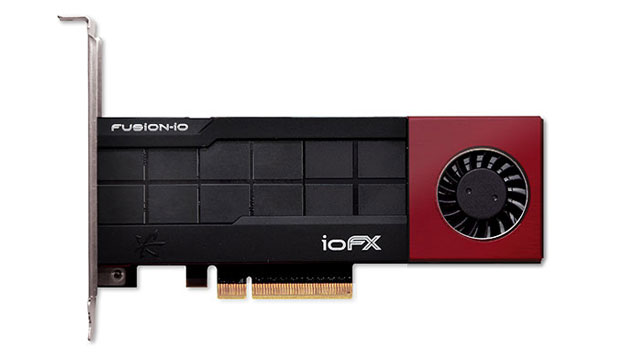Tuned for Workstations, with a Lower Price Point
Fusion-io is targeting VFX artists with the 420 GB Fusion ioFX, a new solid-state memory product that's designed specifically to improve workstation performance for editing, compositing, encoding, transcoding, playback and rendering. The price point is also tuned to hit a sweet spot for VFX — at $2495, it's significantly less expensive than other Fusion-io products.
The Fusion ioFX, announced today for an introduction at NAB next week, is a PCI-Express card loaded with 420 GB of QDP MLC NAND flash memory. Fusion-io's devices don't perform like solid-state drives because they don't rely on the workstation's storage subsystem. Instead, the company wrote its own memory subsystem into the drivers for each supported operating system, allowing the devices to function as another tier of computer memory, utilizing the CPU directly, rather than going through a storage controller.
"It's kind of like adding 420 GB of RAM," Fusion-io Performance Computing Industry Manager Vincent Brisebois told StudioDaily. "It's not quite as fast as RAM, but it is non-volatile, meaning it doesn't disappear when you shut it off. And, depending on the usage pattern, it can be faster than RAM. You no longer have to transfer data from storage to memory because it's actually quicker to keep it on the ioFX memory device."
How fast is it? Brisebois said the ioFX has read bandwidth of 1.4 GB/sec and write performance of 700 MB/sec (for these applications, read performance is much more important than write) with read-access latency of .068 ms. According to Brisebois, that's much faster than SSDs, which he said are limited by their reliance on the existing storage subsystem to about 1 ms.
He also claimed that the ioFX scales more efficiently than SSD when two units are installed. "If you put two ioFX cards in and RAID them together, you get 2.9 GB/sec, which makes it possible to work on stereo 2K and 4K uncompressed content. And [NVIDIA's graphics-card architecture] Cuda recognizes that it's not just storage but a memory device, which means it can actually do memory-pinning and share memory space between two devices." Two ioFX cards wouuld deliver an extra 840 GB of memory — a very comfortable system spec for a VFX artist or compositor.
Another target app for the ioFX is stereo 3D playback. "Stereoscopic film production with high-res cameras has hit a bottleneck," Brisebois says. "In 3D, you can't really use proxies because the 3D effect comes from differences in the pixels, and if you compress the image you're messing with those pixels and thus you're messing with the 3D depth. So you've gone from playing back a quarter-resolution proxy to what is essentially two full-resolution movies." Previous customers for Fusion-io products included Prime Focus, which had
ramped up for its super-tight-deadline conversion job on Clash of the Titans with Fusion-io drives, and Pixomondo, which used them in their pipeline for
Alice in Wonderland and
Hugo. The ioFX is designed to hit a price point that makes the technology more affordable for smaller studios and independent artists.
The ioFX is bundled with Fusion-io's free ioSphere software, a management application that lets IT track usage of the company's products over the netwrok, tracking read-and-write performance, data usage, and estimations of hardware failure that will help facilities plan purchases and scale operations appropriately as different projects come through the door.
Supported operating systems are 64-bit Windows Server 2008 R2, 64-bit Windows 7, Mac OS X 10.6.7/10.7, RHEL 5/6, SLES 10/11, and OELv5/6.
If you want to see Fusion-io at NAB, the technology will be demoed at the Adobe, Assimilate, NVIDIA, Sony Creative Software, The Foundry, and Qube Cinema booths.

Leave a Reply